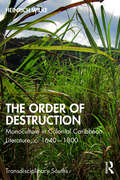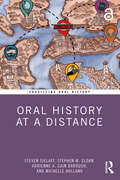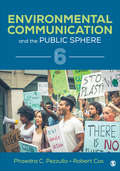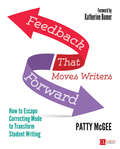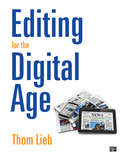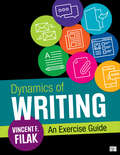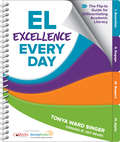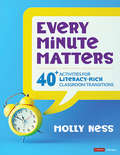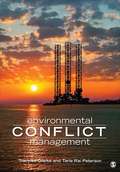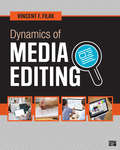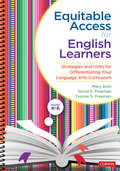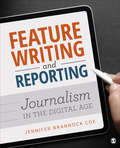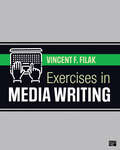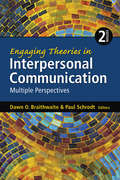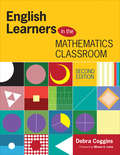- Table View
- List View
The Order of Destruction: Monoculture in Colonial Caribbean Literature, c. 1640-1800 (Transdisciplinary Souths)
by Heinrich WilkeThis book studies sugarcane monoculture, the dominant form of cultivation in the colonial Caribbean, in the later 1600s and 1700s up to the Haitian Revolution. Researching travel literature, plantation manuals, Georgic poetry, letters, and political proclamations, this book interprets texts by Richard Ligon, Henry Drax, James Grainger, Janet Schaw, and Toussaint Louverture.As the first extended investigation into its topic, this book reads colonial Caribbean monoculture as the conjunction of racial capitalism and agrarian capitalism in the tropics. Its eco-Marxist perspective highlights the dual exploitation of the soil and of enslaved agricultural producers under the plantation regime, thereby extending Marxist analysis to the early colonial Caribbean. By focusing on textual form (in literary and non-literary texts alike), this study discloses the bearing of monoculture on contemporary writers’ thoughts. In the process, it emphasizes the significance of a literary tradition that, despite its ideological importance, is frequently neglected in (postcolonial) literary studies and the environmental humanities.Located at a crossroads of disciplines and perspectives, this study will be of interest to literary/cultural critics and historians working in the early Americas and in Atlantic studies, to students and scholars of agriculture, colonialism, and (racial) capitalism, to Marxists and postcolonial critics, and to those working in the environmental humanities and in Global South studies.
Oral History at a Distance (Practicing Oral History)
by Stephen M. Sloan Steven Sielaff Adrienne A. Cain Darough Michelle HollandOral History at a Distance is the first publication to explore both the ideas behind and application of oral history in remote projects.Since the COVID-19 pandemic, working from a distance is now an ongoing and necessary approach in the oral historian’s toolkit. In this volume, the experienced team members of Baylor University’s Institute for Oral History provide a road map for adapting traditional best practices and procedures to this new environment while maintaining the standards oral historians hold dear. The authors present chapters on the range of oral history practice—project design, ethical considerations, project management, interviewing, technology, and preservation. While this book is always concerned with how to do remote oral history well, it also examines the changed dynamics and new considerations of moving from face-to-face projects to distance work. In this, the authors are joined by an international host of practitioners who have had their own experiences with oral history at a distance and share their insights from their work through informative case studies.As the practice of oral history moves into a new era, this book is an essential resource for oral historians—whether they are just starting out or wanting to stay innovative in their endeavors.
Environmental Communication and the Public Sphere
by Robert Cox Phaedra C. PezzulloThe best-selling Environmental Communication and the Public Sphere provides a comprehensive introduction to the growing field of environmental communication. This groundbreaking book focuses on the role that human communication plays in influencing the ways we perceive the environment. Authors Phaedra C. Pezzullo and Robert Cox examine how we define what constitutes an environmental problem and how we decide what actions to take concerning the natural world. The Sixth Edition explores recent events and research, including fast fashion, global youth climate strikes, biodiversity loss, disability rights advocacy, single-use plastic ban controversies, and the COVID-19 pandemic.
Feedback That Moves Writers Forward: How to Escape Correcting Mode to Transform Student Writing (Corwin Literacy)
by Patty McGee"Patty McGee should be called the ′Writer Whisperer.′ She offers brilliant advice for helping struggling writers, accomplished writers, and all those in between." —Debbie Silver, Co-author of Teaching Kids to Thrive The number one challenge of student writers today isn’t word choice, logic, voice, or even grammar and spelling—it’s buy-in. In Feedback That Moves Writers Forward, Patty McGee shares how to’s for teaching that changes the writing-as-obligation vibe for good. She demonstrates the way feedback can inspire students to reach new heights as writers. With Patty’s help, you learn to: Resign from your position as Corrector-in-Chief and be amazed as students eagerly take over responsibility for refining their writing Apply the research on growth mindset and goal setting, whether you use a writing program or a workshop model Use tone, trust, and language to quicken students’ discovery of their writing identities and take risks when they are stuck Use student work to deliver clear, just-in-time feedback during planning, drafting, revising, and editing Use the online printable forms for delivering customized feedback with just the right wording Balance grading and feedback Help writers reflect so they are better able to apply what they learned about content, craft, and style to their future writing One of the bravest things we can do as teachers is to admit when a long held practice isn’t working. Error-focused feedback is one such practice. So put down the red pen, pick up this book, and learn to say the right thing at the right time to develop fearless, original, and intentional writers—in any content area.
Editing for the Digital Age (20160101 #05 College/higher education)
by Thom LiebA Balanced Approach for the Modern Writer and Editor Whether working in a traditional newsroom or as a one-person blogging operation, every good writer needs to become his or her own best editor. Editing for the Digital Age provides editors and writers with the tools necessary to ensure that published material is accurate, readable, and complete. The book provides guidance in copy editing fundamentals, including correcting grammar, conforming the writing to a style guide, and revising material so that it is tightly written and clear. The text is designed for today’s digital publishing landscape and addresses the many issues writers and editors now face on a daily basis—handling legal issues such as liability, copyright, and libel; writing headlines that will attract readers; creating multimedia packages to support an article or post; and using various forms of social media to curate content and connect with audience members. Chapters focus on key areas and themes for editing in the digital age, and "Write Right" writing and grammar exercises are woven into every chapter to progressively build students’ editing skills.
Dynamics of Writing: An Exercise Guide
by Vincent F. FilakDynamics of Writing: An Exercise Guide gives students multiple opportunities to practice their writing skills in-class or as take-home assignments. Each chapter focuses on a different aspect of the newswriting process and offers short-answer, multiple-choice, and writing-prompt activities to help students master the concepts and skills presented in Vincent F. Filak’s comprehensive book. Additional exercises built around the unique demands of online newswriting will prepare students to meet the demands of a changing media landscape. Key Features: "Writing Exercises" enable students to recall & demonstrate their understanding of various elements found in each chapter in Dynamics of News Writing and Reporting. "Practice Writing" exercises empower students to apply their knowledge in a safe, in-class environment. "Live-Action Exercises" encourage students to expand their knowledge and experience through out-of-class reporting and writing opportunities. Bundle this workbook with Dynamics of News Writing and Reporting.
EL Excellence Every Day: The Flip-to Guide for Differentiating Academic Literacy
by Tonya W. SingerTake the Flip-to Book Tour! You have to see this book to believe this book. And once you use this book it will quickly become your most treasured teaching resource. What exactly is so remarkable? All of the best teaching tools in language and literacy are at your fingertips! Just flip to that strategy you want to learn or that literacy goal you want to reach for a wealth of ready-to-use resources to actively engage learners, build academic language, and strategically support literacy instruction. Much more than a resource for EL specialists, EL Excellence Every Day is written for every teacher, with a singular focus on improving the ways we all differentiate literacy instruction. Busy teachers especially will appreciate: Over 85 flip-to strategies that help you engage and support all learners 200+ prompts and linguistic scaffolds to facilitate academic conversations connected to specific literacy goals Lesson-ready resources for essential literacy goals: anticipate before reading, read to understand, read to analyze and infer, and write with text evidence Formative assessment tasks and if/then charts for personalizing teaching to every student Differentiation guides that demonstrate how to adjust supports across EL proficiency levels Intuitive, color-coded design so you can find what you need, when you need it No one lesson or strategy is ever the perfect solution for every student. No one student learns in the same way. If there’s one universal truth in teaching it’s that every child is unique. Devour this book and soon enough you’ll provide the excellent literacy instruction each and every student deserves each and every day. "We need resources that clearly and quickly help us to meet diverse instructional needs every day in every classroom. Tonya Ward Singer’s EL Excellence Every Day: The Flip-to Guide for Differentiating Academic Literacy is such a resource." --JEFF ZWIERS, from the foreword
Every Minute Matters [Grades K-5]: 40+ Activities for Literacy-Rich Classroom Transitions (Corwin Literacy)
by Molly K. NessMake the most of every instructional minute with engaging literacy activities Time—or lack thereof—may be the most precious commodity in the classroom. From covering all the necessary curriculum and imparting life skills to attending meetings and answering emails, educators are faced with real challenges when there never seems to be enough time to do it all. Although teachers don’t have the power to create more minutes in the school day, they do have the power to be effective and efficient with the time given. Molly Ness asks teachers first to examine their use of time in the classroom in order to make more space for literacy. She then introduces 40 innovative activities designed to replace seatwork. These literacy-rich alternatives for classroom transitions are presented alongside Research on instructional time in K–5 classrooms Strategies for how to maximize every minute of instruction Suggestions for improving efficiency to expand independent reading and writing time Reflective practices to help teachers examine how they use the time they have The instructional day is ripe for redesign with a thoughtful and authentic time audit. Every Minute Matters guides educators through that process by outlining literacy-rich activities to optimize transitional times and minimize lost instructional minutes.
Feedback That Moves Writers Forward: How to Escape Correcting Mode to Transform Student Writing (Corwin Literacy)
by Patty McGee"Patty McGee should be called the ′Writer Whisperer.′ She offers brilliant advice for helping struggling writers, accomplished writers, and all those in between." —Debbie Silver, Co-author of Teaching Kids to Thrive The number one challenge of student writers today isn’t word choice, logic, voice, or even grammar and spelling—it’s buy-in. In Feedback That Moves Writers Forward, Patty McGee shares how to’s for teaching that changes the writing-as-obligation vibe for good. She demonstrates the way feedback can inspire students to reach new heights as writers. With Patty’s help, you learn to: Resign from your position as Corrector-in-Chief and be amazed as students eagerly take over responsibility for refining their writing Apply the research on growth mindset and goal setting, whether you use a writing program or a workshop model Use tone, trust, and language to quicken students’ discovery of their writing identities and take risks when they are stuck Use student work to deliver clear, just-in-time feedback during planning, drafting, revising, and editing Use the online printable forms for delivering customized feedback with just the right wording Balance grading and feedback Help writers reflect so they are better able to apply what they learned about content, craft, and style to their future writing One of the bravest things we can do as teachers is to admit when a long held practice isn’t working. Error-focused feedback is one such practice. So put down the red pen, pick up this book, and learn to say the right thing at the right time to develop fearless, original, and intentional writers—in any content area.
Environmental Conflict Management
by Tarla Rai Peterson Tracy Lee ClarkeA step-by-step guide connecting theory to practice Environmental Conflict Management introduces students to the research and practice of environmental conflict and provides a step-by-step process for engaging stakeholders and other interested parties in the management of environmental disputes. In each chapter, authors Dr. Tracylee Clarke and Dr. Tarla Rai Peterson first introduce a specific concept or process step and then provide exercises, worksheets, role-plays, and brief case studies so students can directly apply what they are learning. The appendix includes six additional extended case studies for further analysis. In addition to providing practical steps for understanding and managing conflict, the text identifies the most relevant laws and policies to help students make more informed decisions. Students will develop techniques for public involvement and community outreach, strategies for effective meeting management, approaches to negotiating options and methodologies for communicating concerns and working through differences, and outlines for implementing and evaluating strategies for sustaining positive community relations.
Dynamics of Media Editing
by Vincent F. FilakAs traditional newsrooms staffed by journalists and managed by experienced editors become less and less common, there is an even greater need for all types of professional writers to be fluent in the editorial process. Dynamics of Media Editing emphasizes the broad value of editing as both a tool for journalistic management and an essential skill for individual writers of all stripes. Author Vince F. Filak recognizes editing as an essential process for improving the quality of published writing, something that is relevant and essential to investigative journalists, social media interns, celebrity bloggers, and everyone in between. By organizing the book around skills and by platforms, Dynamics of Media Editing shows students how the basic principles of good editing work across disciplines and media platforms. Key Features The emphasis on transferrable skills and multiple platforms shows students how to use the basic principles of good editing for journalism, PR, advertising, or social media marketing. The book takes a broad approach to editing, demonstrating that it’s not just a skill for managers at newspapers, but rather an essential process for improving all aspects of published writing. This addresses a critical course challenge, in that many students don’t see the relevance of editing in their planned careers. The audience-centric method emphasizes the need to engage one’s audience in order to be a successful writer. "Helpful Hints" boxes provide easy-to-consult lists of dos and don’ts for good writing. "Thoughts From a Pro" boxes allow media professionals from a variety of backgrounds to demonstrate the essential function of the editing process in the workplace.
Editing for the Digital Age (20160101 #05 College/higher education)
by Thom LiebA Balanced Approach for the Modern Writer and Editor Whether working in a traditional newsroom or as a one-person blogging operation, every good writer needs to become his or her own best editor. Editing for the Digital Age provides editors and writers with the tools necessary to ensure that published material is accurate, readable, and complete. The book provides guidance in copy editing fundamentals, including correcting grammar, conforming the writing to a style guide, and revising material so that it is tightly written and clear. The text is designed for today’s digital publishing landscape and addresses the many issues writers and editors now face on a daily basis—handling legal issues such as liability, copyright, and libel; writing headlines that will attract readers; creating multimedia packages to support an article or post; and using various forms of social media to curate content and connect with audience members. Chapters focus on key areas and themes for editing in the digital age, and "Write Right" writing and grammar exercises are woven into every chapter to progressively build students’ editing skills.
Dynamics of Writing: An Exercise Guide
by Vincent F. FilakDynamics of Writing: An Exercise Guide gives students multiple opportunities to practice their writing skills in-class or as take-home assignments. Each chapter focuses on a different aspect of the newswriting process and offers short-answer, multiple-choice, and writing-prompt activities to help students master the concepts and skills presented in Vincent F. Filak’s comprehensive book. Additional exercises built around the unique demands of online newswriting will prepare students to meet the demands of a changing media landscape. Key Features: "Writing Exercises" enable students to recall & demonstrate their understanding of various elements found in each chapter in Dynamics of News Writing and Reporting. "Practice Writing" exercises empower students to apply their knowledge in a safe, in-class environment. "Live-Action Exercises" encourage students to expand their knowledge and experience through out-of-class reporting and writing opportunities. Bundle this workbook with Dynamics of News Writing and Reporting.
Equitable Access for English Learners, Grades K-6: Strategies and Units for Differentiating Your Language Arts Curriculum
by Yvonne S. Freeman David E. Freeman Mary SotoPlain and simple: until our English learners have equitable access to the curriculum, they’ll continue to struggle with subject area content. And if you’re relying on add-on’s to fit in from your language arts basal or a supplementary program, Mary Soto, David Freeman, and Yvonne Freeman are here to equip you with much more effective, efficient, and engaging strategies for helping your English learners read and write at grade level. One assurance right from the start: Mary, David, and Yvonne are not suggesting you reinvent your curriculum. Instead, Equitable Access for English Learners, Grades K-6, focuses on how to fortify foundational practices already in place. First, you’ll learn more about the Equitable Access Approach, then it’s time to dive into the book’s four units of study. Drawing on each unit’s many strategies, you’ll discover how to apply them to any unit in your own language arts curriculum and start differentiating: How to draft and implement language objectives to help English learners meet academic content standards How to make instructional input comprehensible, including translanguaging strategies that draw on your students’ first languages when you don’t know how to speak them How to utilize the characteristics of text to support readers, along with a rubric for determining a text’s cultural relevance How to build students’ academic content knowledge and develop academic language proficiency Each unit addresses a commonly taught topic in today’s language arts programs and comes with ready-to-go review and preview activities, key strategies, grade-level adaptations, reflection exercises, and printable online resources. Taken as a whole, they constitute an all-new approach for providing that equitable and excellent access our English learners so rightfully deserve. "When you adopt our Equitable Access Approach, your students will not only thrive, they’ll also find your language arts curriculum much more meaningful and engaging." —Mary Soto, David E. Freeman, and Yvonne S. Freeman
Dynamics of Media Editing
by Vincent F. FilakAs traditional newsrooms staffed by journalists and managed by experienced editors become less and less common, there is an even greater need for all types of professional writers to be fluent in the editorial process. Dynamics of Media Editing emphasizes the broad value of editing as both a tool for journalistic management and an essential skill for individual writers of all stripes. Author Vince F. Filak recognizes editing as an essential process for improving the quality of published writing, something that is relevant and essential to investigative journalists, social media interns, celebrity bloggers, and everyone in between. By organizing the book around skills and by platforms, Dynamics of Media Editing shows students how the basic principles of good editing work across disciplines and media platforms. Key Features The emphasis on transferrable skills and multiple platforms shows students how to use the basic principles of good editing for journalism, PR, advertising, or social media marketing. The book takes a broad approach to editing, demonstrating that it’s not just a skill for managers at newspapers, but rather an essential process for improving all aspects of published writing. This addresses a critical course challenge, in that many students don’t see the relevance of editing in their planned careers. The audience-centric method emphasizes the need to engage one’s audience in order to be a successful writer. "Helpful Hints" boxes provide easy-to-consult lists of dos and don’ts for good writing. "Thoughts From a Pro" boxes allow media professionals from a variety of backgrounds to demonstrate the essential function of the editing process in the workplace.
Feature Writing and Reporting: Journalism in the Digital Age
by Jennifer Brannock CoxThis new text offers a fresh look at feature writing and reporting in the 21st century. Award-winning professor and author Jennifer Brannock Cox teaches students the fundamentals of feature writing and reporting while emphasizing the skills and tools needed to be successful in the digital era. Packed with the best samples of feature writing today, this practical text gives students ample opportunity to practice their writing as they build a portfolio of work for their future careers. Cox′s special attention on new multimedia and online reporting prepares readers for success in a rapidly changing media landscape.
Exercises in Media Writing
by Vincent F. FilakExercises in Media Writing offers students multiple opportunities to practice their writing skills in-class or as take-home assignments. Each chapter includes review questions and writing-prompt activities to help students master the concepts and skills presented in Vincent F. Filak’s second edition of Dynamics of Media Writing. Additional exercises built around the unique demands of online newswriting will prepare students to meet the demands of a changing media landscape. Key Features: Review Questions help students recall and master core chapter concepts Writing Exercises enable students to recall and demonstrate their understanding of various elements found in each chapter in Dynamics of Media Writing, Second Edition. Bundle this workbook with Dynamics of Media Writing and save! Your students save when you bundle this text with a corresponding student workbook. Order using bundle ISBN 9781544361970.
Engaging Theories in Interpersonal Communication: Multiple Perspectives
by Dawn O. Braithwaite Paul SchrodtWinner of the 2017 NCA Gerald R. Miller Book Award! Use and Understand Interpersonal Communication Theories Engaging Theories in Interpersonal Communication: Multiple Perspectives highlights key theories used to guide interpersonal communication research. The Second Edition features 30 theory chapters written by leading scholars in interpersonal communication, including new coverage of evolutionary theories, Problematic Integration Theory, supportive communication theories, Theory of Motivated Information Management, critical approaches to interpersonal communication, and Media Multiplexity Theory. Each theory chapter follows the same structure to help readers easily find and compare information across theories. An updated introductory chapter maps the history and the current state of interpersonal communication theory since publication of the first edition, based on comprehensive analysis of published scholarship. Presenting both classic and cutting-edge issues, the book organizes theories into three clusters—theories that are individually-centered; theories that are focused on discourse and interaction processes; and theories that examine how communication functions in personal relationships. All authors interweave abstract theoretical concepts with concrete examples in order to maximize readability and comprehension.
Feature Writing and Reporting: Journalism in the Digital Age
by Jennifer Brannock CoxThis new text offers a fresh look at feature writing and reporting in the 21st century. Award-winning professor and author Jennifer Brannock Cox teaches students the fundamentals of feature writing and reporting while emphasizing the skills and tools needed to be successful in the digital era. Packed with the best samples of feature writing today, this practical text gives students ample opportunity to practice their writing as they build a portfolio of work for their future careers. Cox′s special attention on new multimedia and online reporting prepares readers for success in a rapidly changing media landscape.
Equitable Access for English Learners, Grades K-6: Strategies and Units for Differentiating Your Language Arts Curriculum
by Yvonne S. Freeman David E. Freeman Mary SotoPlain and simple: until our English learners have equitable access to the curriculum, they’ll continue to struggle with subject area content. And if you’re relying on add-on’s to fit in from your language arts basal or a supplementary program, Mary Soto, David Freeman, and Yvonne Freeman are here to equip you with much more effective, efficient, and engaging strategies for helping your English learners read and write at grade level. One assurance right from the start: Mary, David, and Yvonne are not suggesting you reinvent your curriculum. Instead, Equitable Access for English Learners, Grades K-6, focuses on how to fortify foundational practices already in place. First, you’ll learn more about the Equitable Access Approach, then it’s time to dive into the book’s four units of study. Drawing on each unit’s many strategies, you’ll discover how to apply them to any unit in your own language arts curriculum and start differentiating: How to draft and implement language objectives to help English learners meet academic content standards How to make instructional input comprehensible, including translanguaging strategies that draw on your students’ first languages when you don’t know how to speak them How to utilize the characteristics of text to support readers, along with a rubric for determining a text’s cultural relevance How to build students’ academic content knowledge and develop academic language proficiency Each unit addresses a commonly taught topic in today’s language arts programs and comes with ready-to-go review and preview activities, key strategies, grade-level adaptations, reflection exercises, and printable online resources. Taken as a whole, they constitute an all-new approach for providing that equitable and excellent access our English learners so rightfully deserve. "When you adopt our Equitable Access Approach, your students will not only thrive, they’ll also find your language arts curriculum much more meaningful and engaging." —Mary Soto, David E. Freeman, and Yvonne S. Freeman
Engaging Theories in Interpersonal Communication: Multiple Perspectives
by Dawn O. Braithwaite Paul SchrodtWinner of the 2017 NCA Gerald R. Miller Book Award! Use and Understand Interpersonal Communication Theories Engaging Theories in Interpersonal Communication: Multiple Perspectives highlights key theories used to guide interpersonal communication research. The Second Edition features 30 theory chapters written by leading scholars in interpersonal communication, including new coverage of evolutionary theories, Problematic Integration Theory, supportive communication theories, Theory of Motivated Information Management, critical approaches to interpersonal communication, and Media Multiplexity Theory. Each theory chapter follows the same structure to help readers easily find and compare information across theories. An updated introductory chapter maps the history and the current state of interpersonal communication theory since publication of the first edition, based on comprehensive analysis of published scholarship. Presenting both classic and cutting-edge issues, the book organizes theories into three clusters—theories that are individually-centered; theories that are focused on discourse and interaction processes; and theories that examine how communication functions in personal relationships. All authors interweave abstract theoretical concepts with concrete examples in order to maximize readability and comprehension.
Environmental Conflict Management
by Tarla Rai Peterson Tracy Lee ClarkeA step-by-step guide connecting theory to practice Environmental Conflict Management introduces students to the research and practice of environmental conflict and provides a step-by-step process for engaging stakeholders and other interested parties in the management of environmental disputes. In each chapter, authors Dr. Tracylee Clarke and Dr. Tarla Rai Peterson first introduce a specific concept or process step and then provide exercises, worksheets, role-plays, and brief case studies so students can directly apply what they are learning. The appendix includes six additional extended case studies for further analysis. In addition to providing practical steps for understanding and managing conflict, the text identifies the most relevant laws and policies to help students make more informed decisions. Students will develop techniques for public involvement and community outreach, strategies for effective meeting management, approaches to negotiating options and methodologies for communicating concerns and working through differences, and outlines for implementing and evaluating strategies for sustaining positive community relations.
Exercises in Media Writing
by Vincent F. FilakExercises in Media Writing offers students multiple opportunities to practice their writing skills in-class or as take-home assignments. Each chapter includes review questions and writing-prompt activities to help students master the concepts and skills presented in Vincent F. Filak’s second edition of Dynamics of Media Writing. Additional exercises built around the unique demands of online newswriting will prepare students to meet the demands of a changing media landscape. Key Features: Review Questions help students recall and master core chapter concepts Writing Exercises enable students to recall and demonstrate their understanding of various elements found in each chapter in Dynamics of Media Writing, Second Edition. Bundle this workbook with Dynamics of Media Writing and save! Your students save when you bundle this text with a corresponding student workbook. Order using bundle ISBN 9781544361970.
EL Excellence Every Day: The Flip-to Guide for Differentiating Academic Literacy
by Tonya W. SingerTake the Flip-to Book Tour! You have to see this book to believe this book. And once you use this book it will quickly become your most treasured teaching resource. What exactly is so remarkable? All of the best teaching tools in language and literacy are at your fingertips! Just flip to that strategy you want to learn or that literacy goal you want to reach for a wealth of ready-to-use resources to actively engage learners, build academic language, and strategically support literacy instruction. Much more than a resource for EL specialists, EL Excellence Every Day is written for every teacher, with a singular focus on improving the ways we all differentiate literacy instruction. Busy teachers especially will appreciate: Over 85 flip-to strategies that help you engage and support all learners 200+ prompts and linguistic scaffolds to facilitate academic conversations connected to specific literacy goals Lesson-ready resources for essential literacy goals: anticipate before reading, read to understand, read to analyze and infer, and write with text evidence Formative assessment tasks and if/then charts for personalizing teaching to every student Differentiation guides that demonstrate how to adjust supports across EL proficiency levels Intuitive, color-coded design so you can find what you need, when you need it No one lesson or strategy is ever the perfect solution for every student. No one student learns in the same way. If there’s one universal truth in teaching it’s that every child is unique. Devour this book and soon enough you’ll provide the excellent literacy instruction each and every student deserves each and every day. "We need resources that clearly and quickly help us to meet diverse instructional needs every day in every classroom. Tonya Ward Singer’s EL Excellence Every Day: The Flip-to Guide for Differentiating Academic Literacy is such a resource." --JEFF ZWIERS, from the foreword
English Learners in the Mathematics Classroom
by Debra S. CogginsResearch-based strategies to reach English learners – now aligned with the Common Core! Instead of just watching your English learners struggle, ensure that they develop high-level math skills and gain greater fluency in English. Debra Coggins’ bestselling book has helped many teachers achieve these intertwined goals by offering strategies that support mathematics learning along with language acquisition for English Learners. Now in its second edition, English Learners in the Mathematics Classroom addresses Common Core requirements, enabling your students to build 21st century skills that will serve them well into the future. Through this trusted resource, you’ll develop specialized teaching strategies that can be adapted across grade levels for students at all stages of English language acquisition. You’ll discover Mathematics lesson scenarios in every chapter, directly connected to the Common Core Standards and the Standards for Mathematical Practice Instructional approaches that promote participation, hands-on learning, and true comprehension of mathematics concepts that benefit all students Sample lessons, visuals, and essential vocabulary that connect mathematical concepts with language development Whether you are rediscovering this book or picking it up for the first time, you’ll find standards-based strategies that will enable your English learners to enjoy and master mathematics. "The ideas and strategies in this book, supported by research and field experiences, will benefit ALL students because they are addressing learning challenges that are common for many learners." Trudy Mitchell, Middle School Math Consultant San Diego, CA "This is by far the best book on designing mathematics instruction for English learners. The short but thorough research reviewed in each chapter gives background for why the teaching tips are so important in developing mathematically literate students." Dan Battey, Associate Professor Rutgers University
